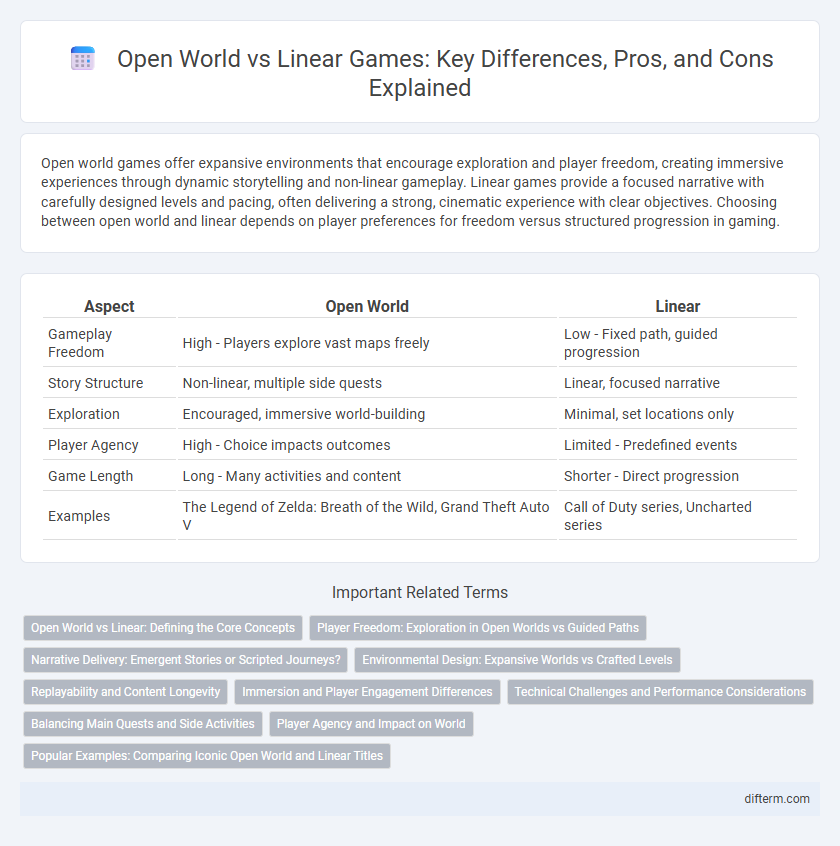Open world games offer expansive environments that encourage exploration and player freedom, creating immersive experiences through dynamic storytelling and non-linear gameplay. Linear games provide a focused narrative with carefully designed levels and pacing, often delivering a strong, cinematic experience with clear objectives. Choosing between open world and linear depends on player preferences for freedom versus structured progression in gaming.
Table of Comparison
| Aspect | Open World | Linear |
|---|---|---|
| Gameplay Freedom | High - Players explore vast maps freely | Low - Fixed path, guided progression |
| Story Structure | Non-linear, multiple side quests | Linear, focused narrative |
| Exploration | Encouraged, immersive world-building | Minimal, set locations only |
| Player Agency | High - Choice impacts outcomes | Limited - Predefined events |
| Game Length | Long - Many activities and content | Shorter - Direct progression |
| Examples | The Legend of Zelda: Breath of the Wild, Grand Theft Auto V | Call of Duty series, Uncharted series |
Open World vs Linear: Defining the Core Concepts
Open world games offer expansive environments that encourage player exploration and non-linear progression, contrasting with linear games that guide players through a fixed narrative path. Open world design emphasizes player freedom, dynamic world interactions, and emergent gameplay, while linear games prioritize tightly controlled storylines and paced challenges. Understanding these core concepts helps developers tailor gameplay experiences to different player preferences and storytelling methods.
Player Freedom: Exploration in Open Worlds vs Guided Paths
Open world games maximize player freedom by offering vast, non-linear environments that encourage exploration and emergent gameplay, allowing players to uncover secrets, complete quests in any order, and interact with diverse ecosystems. Linear games provide guided paths with carefully designed level progression and narrative control, ensuring a focused and immersive storytelling experience without the risk of straying off-course. The choice between open world and linear designs hinges on whether players prioritize autonomous discovery or curated, structured gameplay.
Narrative Delivery: Emergent Stories or Scripted Journeys?
Open World games foster emergent stories through player-driven choices, creating dynamic narratives that evolve based on exploration and interaction within expansive environments. Linear games deliver scripted journeys with tightly woven storylines, ensuring a controlled and immersive narrative experience crafted by developers. The contrast lies in player agency shaping the story: open worlds prioritize freedom and unpredictability, while linear games emphasize focused storytelling and emotional impact.
Environmental Design: Expansive Worlds vs Crafted Levels
Open world games feature expansive environments that encourage exploration and player agency, with diverse ecosystems and dynamic weather systems enhancing immersion. Linear games focus on meticulously crafted levels where environmental design guides the player through a carefully controlled narrative and gameplay experience. The contrast lies in open worlds offering freedom within vast terrains, while linear games prioritize detail and pacing through tailored, intentional spaces.
Replayability and Content Longevity
Open world games offer extensive environments with dynamic quests and side activities, significantly enhancing replayability and content longevity by allowing players to explore diverse gameplay paths. Linear games, while often delivering tightly crafted narratives and focused gameplay, typically have limited replay value due to their predefined story arcs and set levels. The expansive nature of open world design supports continuous player engagement and discovery, making it a preferred choice for gamers seeking long-term content richness.
Immersion and Player Engagement Differences
Open world games provide vast, explorable environments that foster deep immersion by allowing players to interact freely with dynamic ecosystems and nonlinear narratives. Linear games concentrate on scripted experiences and focused storytelling, offering high player engagement through tight pacing and carefully crafted challenges. Immersion in open world titles often stems from player-driven discovery, whereas linear games rely on direct narrative impact and guided gameplay to maintain attention.
Technical Challenges and Performance Considerations
Open world games demand extensive real-time streaming of vast environments, leading to complex memory management and increased CPU and GPU load, which can cause performance bottlenecks without efficient optimization techniques like level-of-detail scaling and dynamic loading. Linear games offer more controlled performance environments with predefined paths, allowing developers to optimize hardware utilization effectively and reduce the chances of frame rate drops. Technical challenges in open world design include seamless world rendering and AI pathfinding over large maps, whereas linear games primarily focus on detailed asset quality and scripted events to enhance immersion.
Balancing Main Quests and Side Activities
Balancing main quests and side activities in open world games enhances player immersion by offering freedom without sacrificing narrative focus. Linear games emphasize a tightly woven storyline with minimal distractions, ensuring a consistent pacing and engagement throughout the experience. Effective game design blends open world exploration with meaningful side content that complements main objectives, maintaining player motivation and depth.
Player Agency and Impact on World
Open world games provide extensive player agency by allowing choices that dynamically alter the game environment and narrative paths, creating a personalized experience. Linear games offer a curated storyline with limited player influence, ensuring a controlled and focused progression that highlights specific plot points. The impact of player decisions in open worlds often leads to diverse outcomes and emergent gameplay, while linear titles emphasize tightly woven story arcs with predetermined consequences.
Popular Examples: Comparing Iconic Open World and Linear Titles
Open world games like The Legend of Zelda: Breath of the Wild and Grand Theft Auto V offer vast, immersive environments that encourage exploration and player freedom. In contrast, linear titles such as the Call of Duty series and Uncharted provide tightly controlled narratives with focused gameplay sequences to deliver intense, story-driven experiences. These iconic examples highlight how open world and linear designs cater to different player preferences within the gaming industry.
Open World vs Linear Infographic

 difterm.com
difterm.com